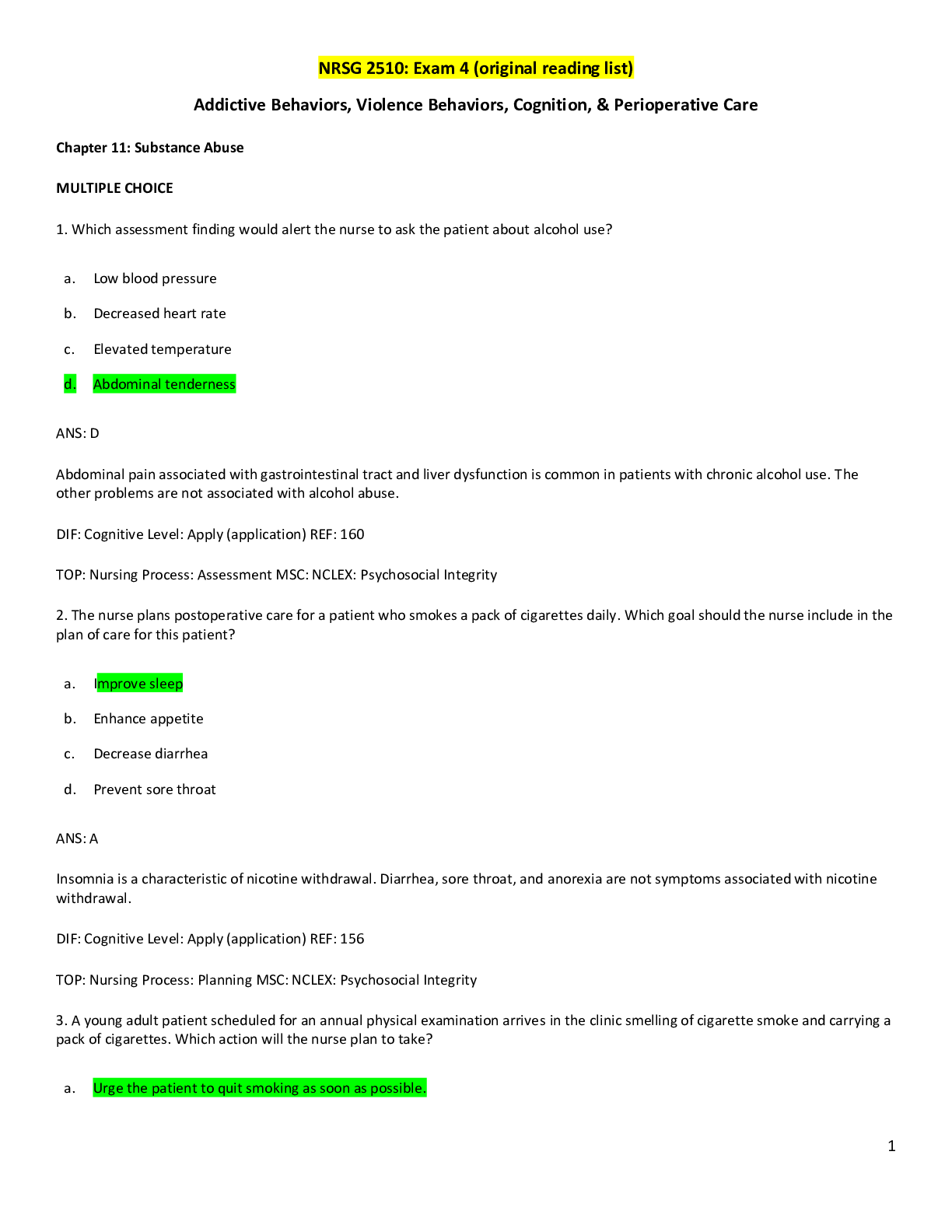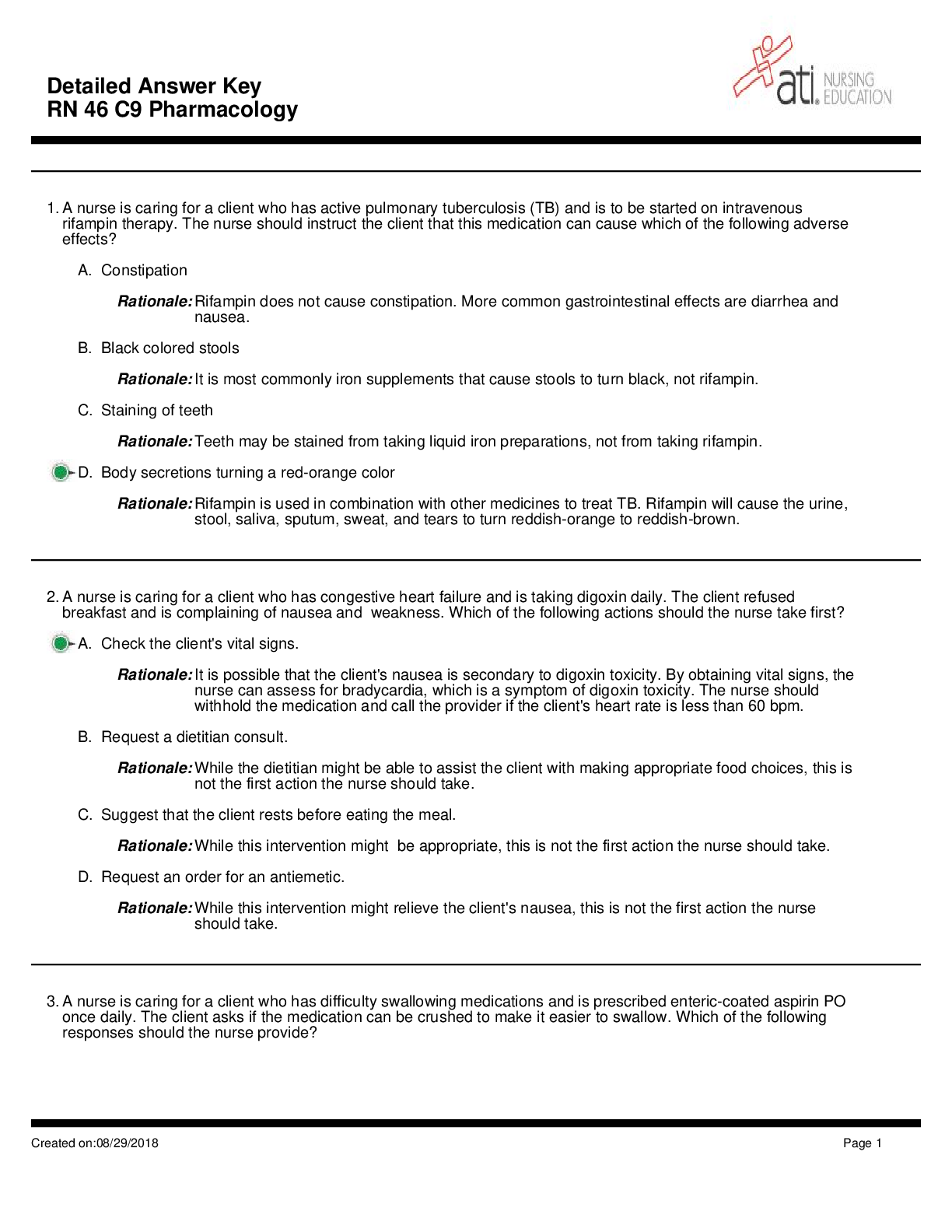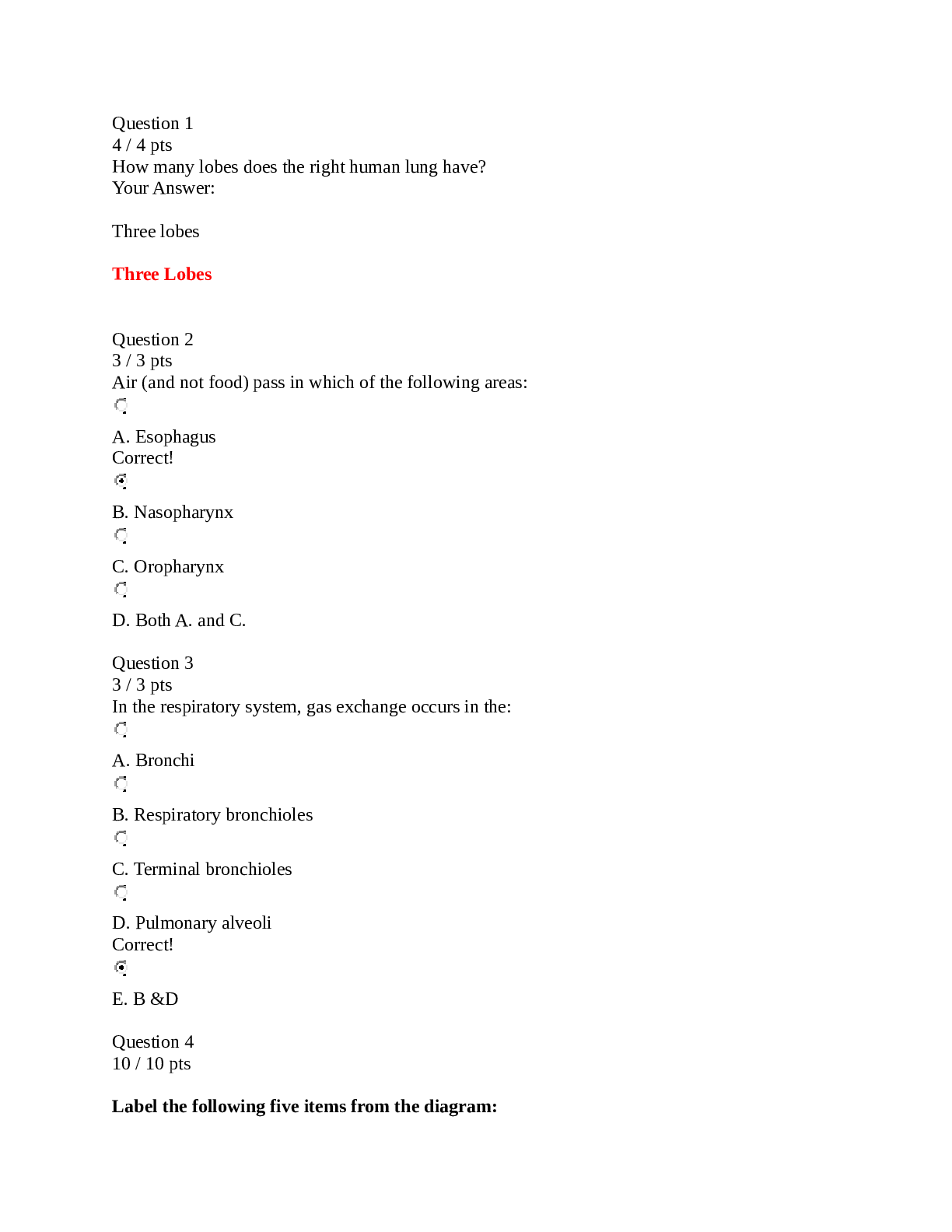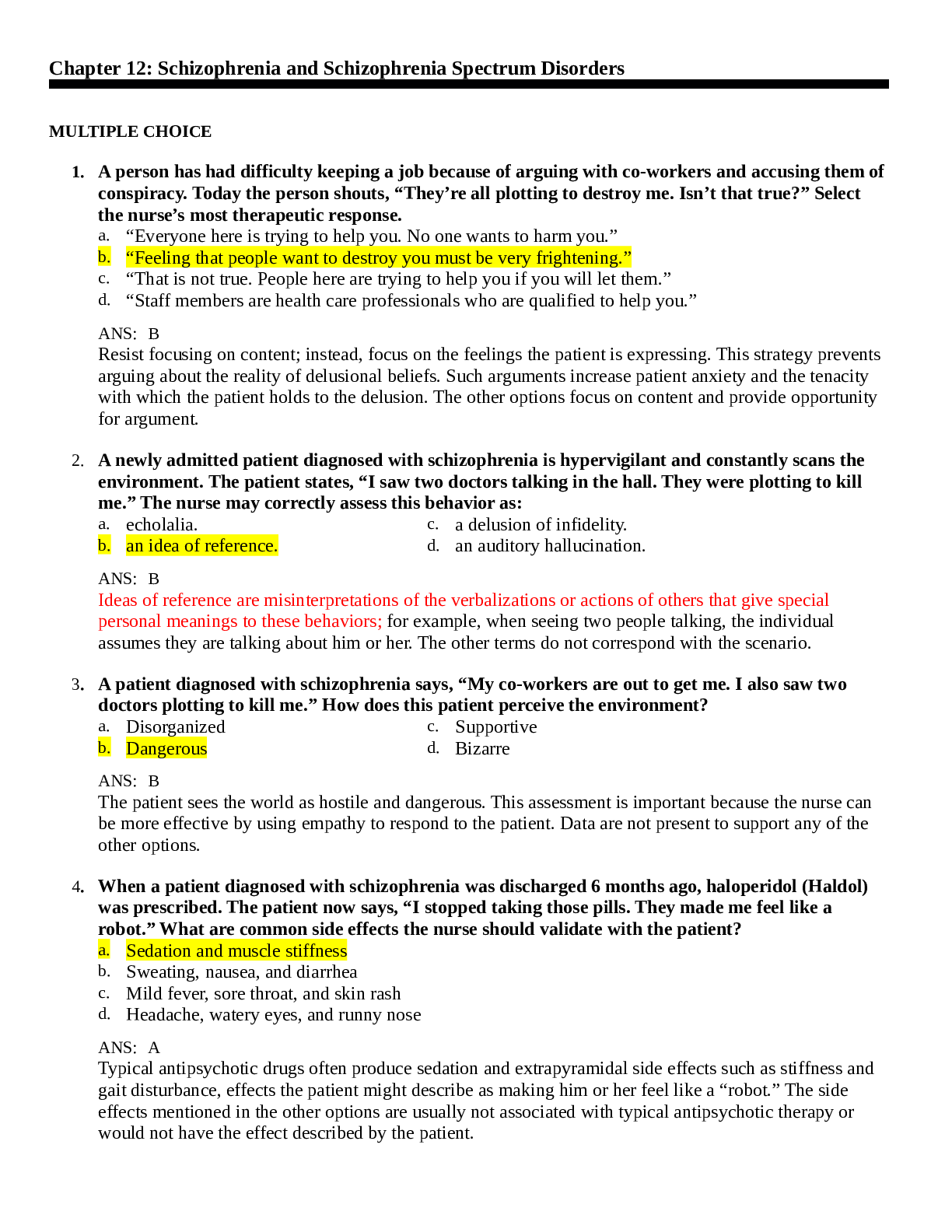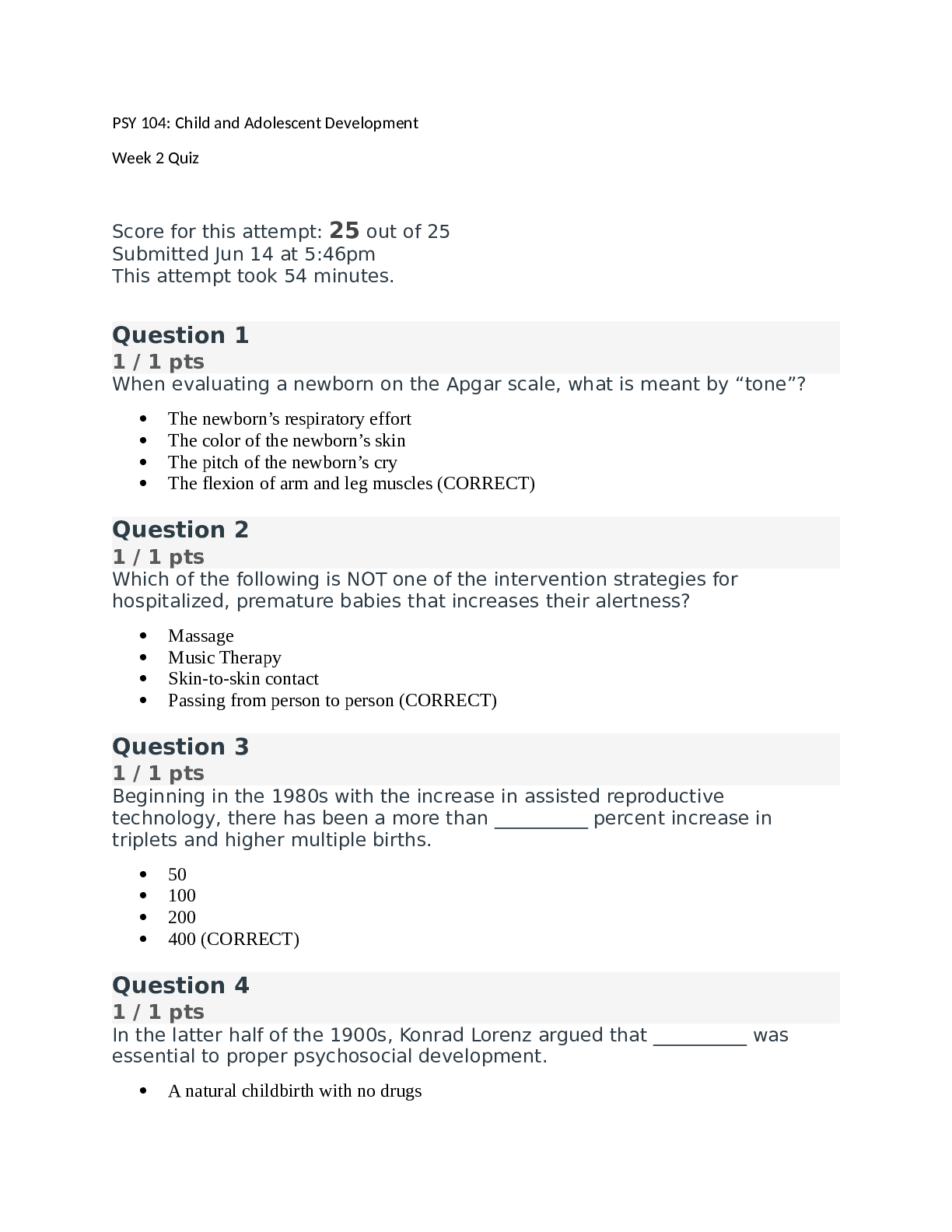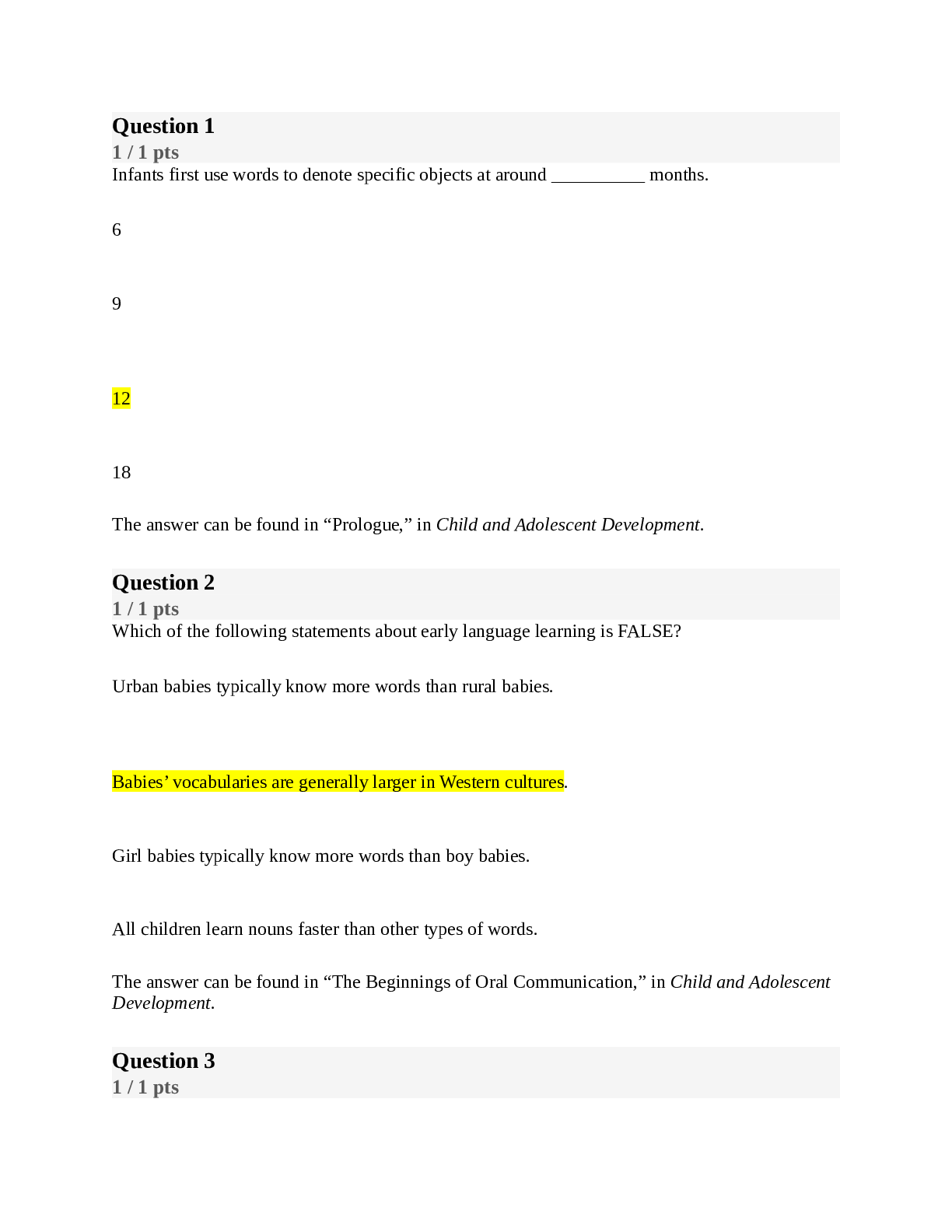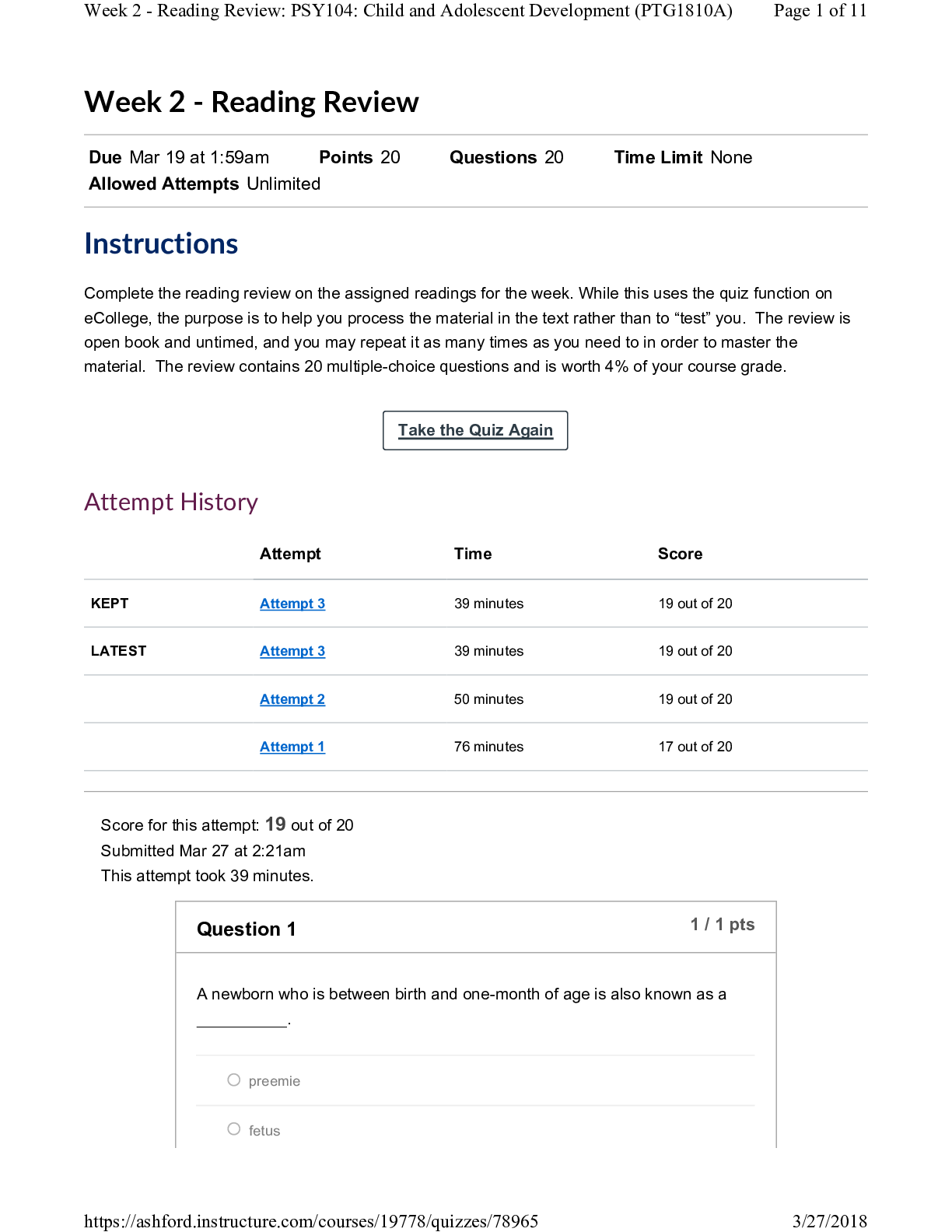*NURSING > EXAM > MCB4203 Exam 4 Test Bank (GRADED A) QUESTIONS AND ANSWER KEY PROVIDED | 100% GUARANTEED PASS. (All)
MCB4203 Exam 4 Test Bank (GRADED A) QUESTIONS AND ANSWER KEY PROVIDED | 100% GUARANTEED PASS.
Document Content and Description Below
1. Aminoglycosides are bacteriostatic antibiotics T/F false 2. Quinolones affect the replication of DNA. T/F true 3. Pharmaceutical companies synthesize antibiotics in the laboratory. T/F true 4. A... ntibiotics are administered only for short periods of time because they have side effects on the patient. T/F true 5. Broad-spectrum antibiotics are often used when the pathogen has not been identified. T/F true 6. Broad-spectrum antibiotics mainly kill gram-positive bacteria. T/F false 7. Tetracyclines cause discoloration of teeth in children. T/F true 8. Rifampin inhibits the activity of bacterial RNA polymerase. T/F true 9. Streptogramins inhibit bacterial DNA replication. T/F false 10. Trimethoprim inhibits tetrahydrofolate biosynthesis. T/F true 11. Ketolides are new derivatives of erythromycin antibiotics. T/F true 12. The beta-lactam ring in penicillin can be cleaved to inactivate the antibiotic. T/F true 13. The beta-lactam ring in penicillin can be modified to increase the spectrum of antibiotic activity. T/F true 14. The formation of a beta-lactam–serum protein conjugate can evoke an immune response causing an allergic reaction. T/F true 15. Taking antibiotics can make you more susceptible to other infections. T/F true 16. Isoniazid, one of the primary antibiotics used against tuberculosis, inhibits mycolic acid biosynthesis. T/F true 17. Antibiotic resistance is a consequence of the mutagenic action of the antibiotic on the bacterium. T/F false 18. Antibiotic resistance is clinically important because it results in increased toxicity. T/F true 19. 19. Antibiotic resistance is clinically important because it results in increased morbidity and mortality. T/F true 20. Antibiotic resistance is clinically important because it results in increased costs. T/F true 21. Misuse of antibiotics has resulted in greater numbers of antibiotic-resistant organisms. T/F true 22. The patient’s normal microbiota can serve as a reservoir for antibiotic resistance genes. T/F true 23. Which of the following is the easiest way for bacteria to develop antibiotic resistance? A. Generate a mutation to alter the target protein. B. Add a functional group to the antibiotic. C. Acquire a conjugative plasmid harboring an antibiotic resistance gene. D. Mutate the gene that regulates the antibiotic resistance genes. E. Mutate the efflux pump so that it pumps out the antibiotics faster than they can accumulate in the bacterial cell. 24. Bacteria can become resistant to fluoroquinolones by producing a mutation in DNA Gyrase T/F true 25. Some members of enterococci are resistant to Vancomycin, a last-resort antibiotic that binds to the dipeptide of N-acetyl muramic acid within the peptidoglycan. T/F true 26. The enterococci develop resistance by replacing a dipeptide with D-Ala-D-lactate, which is not bound by the antibiotic. T/F true 27. The most common way antibiotic resistance genes are spread is by plasmids or conjugative transposons. T/F true 28. The main source of antibiotic resistance genes is believed to be between bacteria found in the colon. T/F true 29. The term ‘‘opportunistic pathogen’’ is used to describe a microorganism that rarely causes infections in healthy people. T/F true 30. A Pangenome may consist of the following: a. pathogenicity islands b. lysogenic bacteriophages c. plasmids d. transposons e. all the above 31. Toxic shock syndrome is associated with which of the following? a. Superantigens b. Cytokine excess c. Enterotoxin d. LPS e. all the above 32. Exfoliate exotoxins target which of the following? a. desmoglein b. plasminogen c. cell membranes d. inactive C3b e. all the above 33. S.aureus is generally considered to be an intracellular pathogen T/F true 34. MRSA is thought to be a hospital specific phenomenon T/F true 35. Biofilm embed in all the following except? a. polysaccharide b. protein c. DNA d. teeth e. A metal catheter 36. P. aeruginosa virulence factors include all of the following except: a. Flagellum b. Siderophores. c. Hemolysins d. LPS e. biofilm 37. Superbugs include all the following except: a. E. coli b. S.aureus c. A. baumannii d. M.tuberculosis e. MRSA 38. All the following are arthropod-borne infections except: a. malaria b. Lyme disease c. plague d. typhus e. typhoid 39. S epidermidis predominates over S aureus on skin because of the predominant of autoinducer peptides T/F true 40. S. Epidermidis pathogenicity is reduced by which of the following compounds? a. capsule formation b. proteases c. polyglutamic acid d. antimicrobial peptides e. none of the above 41. Which of the following shows little resistance to a variety of antibiotics? a. B fragilis b. P.aeruginosa c. A.baumannii d. E.coli e. P.gingivalis 42. Virotyping as a means of classification does not rely on which of the following? a. K capsule b. dissemination c, adherence d. toxin production e. effect on host cells 43. E. coli is the most common cause of neonatal meningitis T/F true 44. Periodontal disease is linked to which of the following? a. P. gingivalis b. F. nucleatum c. B. fragilis d. Bacteroides e. All of the above 45. Staphylococcus aureus causes more burn infections than P. aeruginosa because of its biofilm and resistance factors? T/F false 46. Both B. cenocepacia and P. aeruginosa. is a common cause of pneumonia in cystic fibrosis? T/F false 47. Bacteria that have shown serious resistance to antibiotics include all of the following except: a. S. aureus b. N. meningitidis c. M. tuberculosis d. P.aeruginosa e. Enterobacteriaceae 48. Which of the following is a correct statement? a. E. chaffeensis is to deer as Borrelia burgdorferi is to ticks b. E. chaffeensis is more likely to cause illness in the elderly than Borrelia burgdorferi c. E. coli trails behind Group B Streptococci as the predominant pathogen observed in early-onset infections among very low birthweight infants. 49. Which of the following is not a common cause of infant meningitis a. L. monocytogenes b. S. aureus c. S. pneumonia d. Pseudomonas e. E. coli 50. Bacteria are likely to enter the cerebrospinal fluid through which of the following mechanisms? a. Transcellular movement across the endothelial cell b. Paracellular movement by disruption of intercellular tight junctions c. Transport across the blood-brain barrier and blood-CSF barriers within phagocytes d. d. All the above 51. Antimicrobial peptides work by a. inhibiting protein synthesis b. disrupting the plasma membrane c. complimentary base pairing with DNA d. inhibiting cell wall synthesis e. hydrolyzing peptidoglycan 52. In what way are semisynthetic penicillin’s and natural penicillin alike? a. Both are broad spectrum b. both are resistant to penicillinase c. both are resistant to stomach acid d. both are bactericidal e. both are based on beta-lactam 53. Which of the following antibiotics is NOT bactericidal? a. aminoglycosides b. cephalosporins c. polyenes d. rifampicins e. penicillin 54. The antibiotic tetracycline binds to the 30S subunit of the ribosome, as shown above. The effect is to a. prevent attachment of DNA b. prevent peptide formation c. interfere with the attachment of the tRNA to mRNA-ribosome complex d. prevent transcription e. stop the ribosome from along the mRNA The following data were obtained from a broth dilution test. Concentration of Antibiotic X Growth Growth in Subculture 2 μg/ml + + 10 μg/ml - + 15 μg/ml - - 25 μg/ml - - 55. In Table above, the minimal bactericidal concentration of antibiotic X is a. 2 μg/ml. b. 10 μg/ml. c. 15 μg/ml. d. 25 μg/ml. e. The answer cannot be determined based on the information provided. 56. In Table above, the minimal inhibitory concentration of antibiotic X is a. 2 μg/ml. b. 10 μg/ml. c. 15 μg/ml. d. 25 μg/ml. e. The answer cannot be determined based on the information provided. 57. To date, most of our natural antibiotics have been found to be produced by members of what genus? a. Streptomyces b. Bacillus c. Penicillium d. Paenibacillus e. Cephalosporium 58. Which of the following statements is FALSE? a. Fluoroquinolone inhibits DNA synthesis. b. Acyclovir inhibits DNA synthesis. c. Amantadine inhibits the release of viral nucleic acid. d.Interferon inhibits glycolysis. e. Azoles inhibit plasma membrane synthesis. 59. Which of the following organisms would MOST likely be sensitive to natural penicillin? a. helminths b. Streptococcus pyogenes c. penicillinase-producing Neisseria gonorrhoeae d. Penicillium e. Mycoplasma 60. Which of the following statements about drug resistance is FALSE? a. It may be carried on a plasmid. b. It may be transferred from one bacterium to another during conjugation. c. It may be due to enzymes that degrade some antibiotics. d. It is found only in gram-negative bacteria. e. It may be due to increased uptake of a drug. 61. Opportunistic infections are likely to a. Present in small numbers b. Be a wild specie c. Be not resistant to treatment d. Have undergone community shift to a virulent form e. Both b and d. 62. Staphylococcus aureus is found in fewer than 20% of human respiratory regions False 63. Common examples of virulence for Staphylococcus aureus do NOT include which of the following? a. Impetigo b. Food poisoning c. Tampon shock d. Pneumonia e. Endocarditis 64. Exfoliate toxins associated with Staphylococcus aureus may cause which of the following? a. impetigo b. hemolysis c. leukocytic membrane lysis d. All the above 65. Adhesins associated with bacteria are known to use enzymes to NOT do which of the following? a. Dissolve the extracellular matrix b. Expose more binding sites c. reduce bacterial spread d. induce fibrinolysis 66. A Precipitation Protein is likely to bind the Fc part of an antibody to enhance macrophage binding False 67. Which of the following proteins form during the exponential growth phase a. Enterotoxin B b. TSST-1 c. α-Toxin d. Coagulase e. None of the above 68. S. epidermidis strains lack the enzyme coagulase that converts fibrinogen to fibrin T/F true 69. S. epidermidis bacteria are easily removed if they form a biofilm on a prosthesis T/F false 70. S. pneumonia is known to cause all of the following except a. pneumonia b. meningitis c. otitis d. bacteremia e. osteitis 71. S. pneumonia colonization is a prerequisite for invasion in humans T/F true 72. Children should be vaccinated with which S. pneumoniae vaccine? a. PCV-7+ b. A 23-capsular vaccine to generate more antibodies 73. S. pneumonia is known to adhere to epithelia cells using which of the following? a. pili b. adhesins c. neuraminidase d. all the above 74. S. pneumonia is known to be resistant to which of the following antibiotics except? a. Vancomycin b. β-lactams c. Erythromycin d. Chloramphenicol 75. C. difficile grows slowly while other colonic bacteria can repopulate the colon after exposure to antibiotics T/F false 76. A pseudomembrane is a sheet like layer of bacteria T/F false 77. With E.Coli induced traveler’s diarrhea is caused by a heat-labile toxin (HST) AND a heat-stabile toxin (HLT) T/F true 78. Which of the following bacteria is NOT commonly associated with Super resistance? a. Acinetobacter baumannii b. MRSA c. CAMRSA d. Mycobacterium tuberculosis e. S. pneumoniae 79. Opportunistic infections exclude which of the following? a. Aseptic meningitis. b. Toxoplasmosis. c. PCP, a type of pneumonia. d. Esophageal candidiasis e. Kaposi's sarcoma 80. Biological warfare is least likely to include the use of a. biological toxins b. bacteria c. viruses d. fungi 81. The MIC is always above the MBC if measured using a Kirby Bauer disc method to test antibiotic susceptibility. T/F false 82. Chemotherapeutics are biologically equivalent to antibiotics. T/F true 83. The periplasmic space in bacteria contains efflux pumps. T/F true 84. Folic acid is a metabolic derivative of PABA found in bacteria. T/F true 85. Cytokines inducing shock associated with Staphylococcus aureus include a. TSST-1 b. Staph exotoxin c. TSST-a d. Complexes that react with β-cells 86. Chemical defenses applied to nonbiological surfaces: a. Disinfectants b. Antiseptics c. Antibiotics d. Chemotherapeutics 87. More bacteria are killed when a. MIC is low b. MIC is high 88. Disinfectants likely to oxidise bacteria include: a. Alcohols b. Formaldehyde c. Phenols d. Halides e. Ethylene Oxide 89. Antibiotics are likely to display a. No Differential toxicity b. No spectrum c. No Bioavailability d. None of the above 90. Genomic-based therapeutics target a. Highly conserved bacterial genes b. Low conserved bacterial genes c. Genes unique to humans d. Genes used in low throughput screening e. None of the above 91. Anti-bacterial genomic-based compounds suffer from: a. Low number of antibiotic compounds b. Lack of annotated bacterial gene isolation c. Gene redundancy d. Gene duplicity e. All the above 92. Antibiotics inhibiting transpeptidation include a. Augmentin b. Vancomycin c. Gentamycin d. Erythromycin e. Both a and b 93. Tetracyclines are likely to bind a. 23sRNA in the 50S subunit of bacterial ribosomes b. 16sRNA in the 30S subunit of bacterial ribosomes c. 15sRNA in the 50S subunit of bacterial ribosomes d. 23sRNA in the 30S subunit of bacterial ribosomes e. None of the above 94. Drugs that damage the bacterial RNA polymerase include a. Ciprofloxacin b. Synercid c. Gentamycin d. Rifampicin e. Steptomycin 95. Chemotherapeutics include a. Trimethoprim b. Clindamycin c. Cefobid d. Streptomycin e. Penicillin 96. Drugs that interfere with bacterial DNA replication include a. Oxazolidinones b. Streptomycin c. Metronidazole d. Ciprofloxacin e. Glycopeptides 97. Macrolides are mostly bacteriostatic T/F true 98. Drugs that interfere with bacterial tRNA include a. Oxazolidinones b. Streptomycin c. Metronidazole d. Ciprofloxacin e. Mupirocin 99. Bacteria that are known opportunists include a. S. epidermidis b. C. difficile c. Cytomegalovirus d. C. albicans e. C. immitis 100. Opportunistic bacteria are likely to a. Be Present in small numbers b. Be laboratory versus wild types c. Resist community shift d. Form within the same genus e. Succumb to treatment 101. S. Aureus is not likely to be a. Found in 43% of human respiratory tracts b. Be linked to CA-MRSA c. Contain TSST-1 d. An enterotoxin e. Trigger MHC-1 complexes to release cytokines 102. Exotoxins are not likely to: a. Cause impetigo b. Be produced extensively by E.coli c. Dissolve clots d. Damage Leucocytic membranes e. Hemolyze Erythrocytes 103. Adhesins contribute pathogenicity to Exoenzymes a. True b.False true 104. Closely bound bacteria are known to: a. Find binding sites b. Find sources of nutrition c. Avoid hyaluronidase and surface proteases d. Dissolve extracellular matrix components e. None of the above 105. The exponential growth phase of bacteria will likely show development of: a. Alpha toxin b. TSST-1 c. Clumping factor d. Enterotoxin-B e. None of the above 106. C3b activity is disrupted by fibrinolysis a. True b. False true 107. The crystalline part of the antibody is responsible for macrophage binding? a. True b. False true 108. Secreted proteins are more likely to be produced in the stationary phase? a. True b. False true 109 S.aureus is more likely to accidentally be found on biofilms? a. True b. False true 110. Biofilms are a. Multi-bacterial b. Induce weak reversible bonds c. Use cell adhesion molecules d. Ubiquitous e. All of the above 111. Colonization with a virulent serotype is the minor reservoir for transmission of S. pneumoniae among humans a. True b. False false 112. S. pneumoniae is known to have: a. Genetic strain diversity b. Few serotypes c. Lack transformability with other bacteria d. No vaccine for children e. None of the above 113. S. pneumoniae is known for the following: a. Primarily an intracellular pathogen b. Produce mild inflammatory responses c. Release hydrogen peroxide against antigen presenting cells d. Lack hyaluronidase e. None of the above 114. The drug most likely to damage S. pneumoniae a. Vancomycin b. Chloramphenicol c. Erythromycin d. Tetracycline e. None of the above 115. C. difficile is not able to a. Grow faster than most other colonic bacteria b. Repopulate the colon after a yeast infection c. Repopulate the colon after antibiotics d. Produce a layer of debris in the inner layer of the colon e. Use an A-B type toxin 116. Gram negative opportunists exclude: a. B fragilis b. Baumannii c. P.aeruginosa d. E.coli e. M.luteus 117. Which of the following is true for E.coli? a. The O antigen determines the serotype b. The H flagellar antigen determines the serogroup c. The K antigen determines the capsule type d. The S antigen determines the serotype e. None of the above 118. Traveller’s diarrhea is associated with: a. An heat stable toxin b. An heat labile toxin c. Raised intracellular GMP levels d. Both a. and b. e. All the above 119. Pan-resistant bacteria excludes: a. P.aeruginosa b. CAMRSA c. M.tuberculosis d. A.baumannii e. None of the above 120. Pan-resistant bacteria adaptation excludes: a. neutralizing the antibiotic before it has a "killing" effect b. pumping out the antibiotic from cells c. changing the site (or receptor) where the antibiotic normally works d. limited genetic material sharing with other bacteria e. developing multidrug and extensive drug resistance in M.tuberculosis [Show More]
Last updated: 1 year ago
Preview 1 out of 14 pages
Instant download
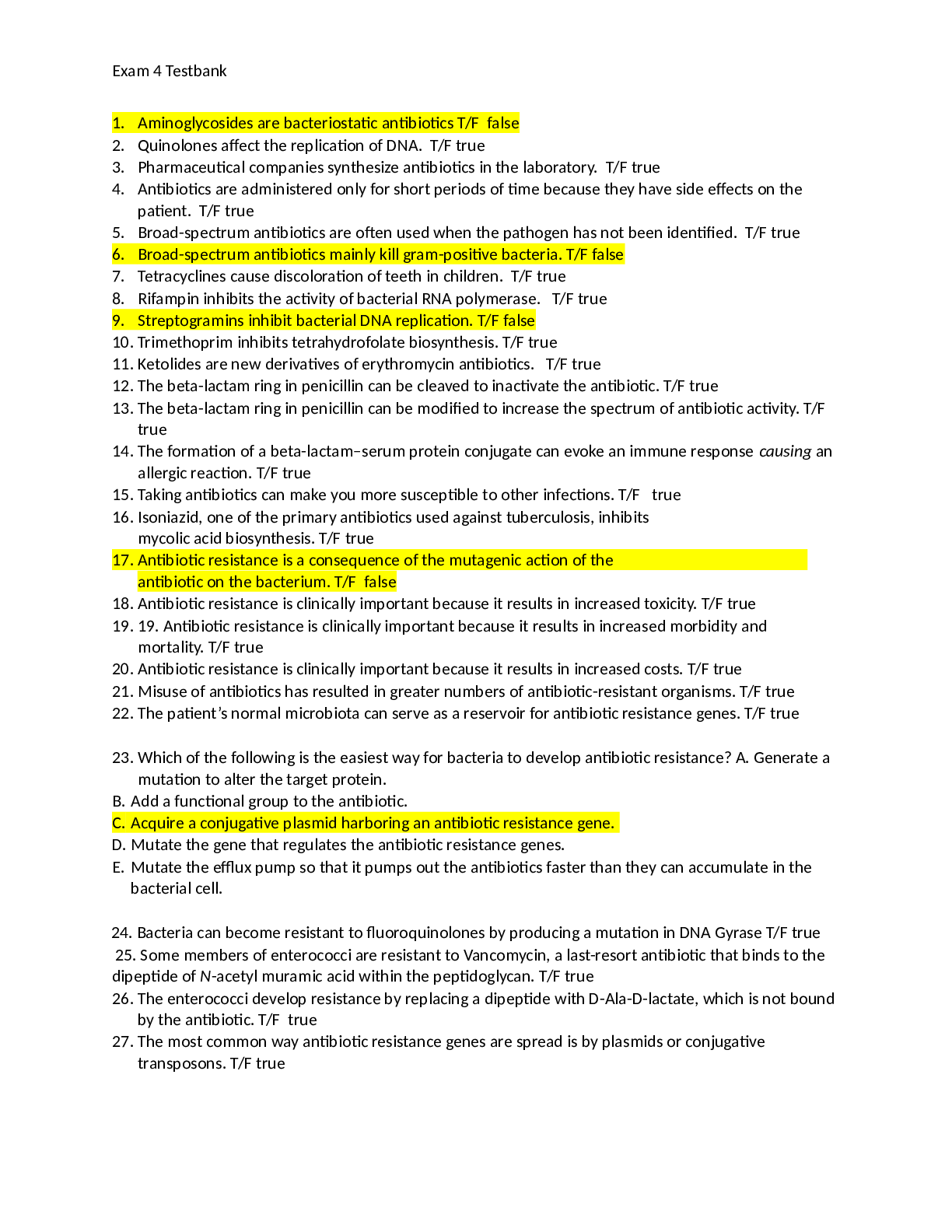
Buy this document to get the full access instantly
Instant Download Access after purchase
Add to cartInstant download
Reviews( 0 )
Document information
Connected school, study & course
About the document
Uploaded On
Jun 22, 2021
Number of pages
14
Written in
Additional information
This document has been written for:
Uploaded
Jun 22, 2021
Downloads
0
Views
41






.png)






